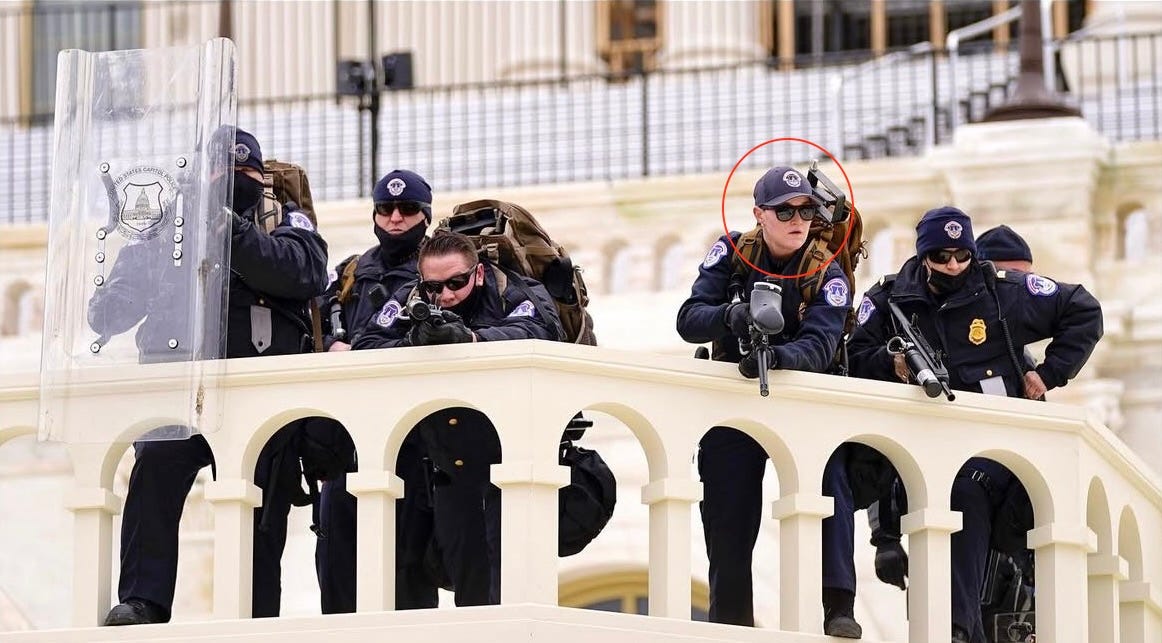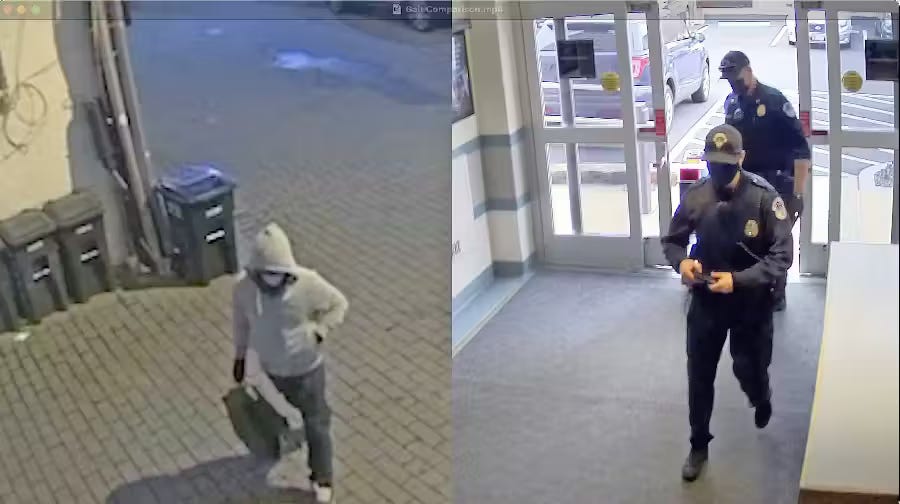BOMBSHELL: Former Capitol Police Officer a Forensic Match for Jan. 6 Pipe Bomber
New article from The Blaze reveals what could be the biggest scandal in recent American history.
It’s a scene that feels ripped from a political thriller: a former Capitol Police officer, now working for the CIA, quietly living in suburban Virginia. Her home is suddenly under police watch. A journalist, parked nearby, gets pulled over. Inside intelligence sources are whispering that she’s a “forensic match,” a 94 to 98 percent gait match, to the mysterious hooded figure who planted the Jan. 6 pipe bombs.
If you wrote this as a screenplay, it would be called unbelievable. But that’s exactly what Blaze Media reported this week.
The story, sourced to intelligence insiders, forensic analysts, and former federal agents, alleges that Shauni Rae Kerkhoff, a 31-year-old former U.S. Capitol Police officer, is the woman seen on surveillance video planting the bombs the night before Jan. 6, 2021. The Blaze commissioned gait-analysis software that compared Kerkhoff’s distinctive limp, stride length, and hip rotation to the suspect’s. The result: a 94–98% match.
It’s the kind of revelation that should dominate headlines. Yet as of this writing, corporate media outlets have stayed almost completely silent, and the FBI has yet to make a statement.
The story beneath the story
The Blaze article reads like the reveal of a five-year mystery that federal investigators failed, or refused, to solve. The FBI, after pouring resources into the Jan. 6 prosecutions, couldn’t find the pipe bomber despite high-definition footage, a half-million-dollar reward, and geolocation data from D.C. surveillance systems.
Now, a conservative outlet and a handful of independent sleuths claim to have done what the most powerful intelligence agency in the world could not, or would not, do.
If that’s true, it’s one of the biggest journalism coups in years. But whether it’s true or not, it tells us something profound about the world we now inhabit: the monopoly on narrative has collapsed.
The forensic thread
The Blaze’s investigation weaves together an astonishing trail:
Kerkhoff’s background as a Capitol Police officer trained in “less-lethal” munitions who was caught on surveillance firing projectiles at protesters on Jan. 6.
Her career shift to a security detail at the CIA.
An injury from her days as a Division I soccer goalie that left her with a subtle limp — the same gait anomaly seen in the bomber video.
And the claim that FBI surveillance teams were literally “one door away” from the suspect’s residence days after Jan. 6, before being abruptly pulled off the case.
If this sounds like conspiracy fiction, that’s because it feels like it. But The Blaze isn’t presenting it as speculation; they’re framing it as a forensic finding corroborated by unnamed intelligence sources and a former FBI agent who now says bluntly: “They were f**king in on it.”
Even if only half of that is true, it opens a Pandora’s box of questions about the FBI’s investigation, about internal accountability, and about whether the narrative surrounding Jan. 6 has been more stage-managed than we’ve been led to believe.
The cinematic collapse of credibility
I’ve spent my career behind the camera, telling stories about power, truth, and how narrative shapes belief. What fascinates me here isn’t just whether the Blaze story is accurate: it’s what it reveals about our national psychology.
In the old world, this kind of allegation would’ve been impossible to publish outside of a major newsroom. Editors would demand clearance from legal, corroboration from official sources, a nod from “authoritative institutions.”
Today, that scaffolding of trust is gone. The Blaze can drop a story like this directly to millions, bypassing every legacy gatekeeper. And in the same breath, CNN, the Washington Post, and the New York Times can ignore it entirely, hoping silence will smother virality.
But silence doesn’t work anymore. In the decentralized media ecosystem, silence is gasoline.
Independent media has become both the investigative arm and the opposition party. Its audience doesn’t just consume; it participates, investigates, and distributes. When the FBI says, “We’ve conducted all logical investigative steps,” and yet a YouTube researcher produces higher-quality video evidence than the Bureau, the institutional façade starts to crack.
Information warfare in the age of disbelief
Whether you trust The Blaze or not, there’s an undeniable phenomenon at play: we are witnessing the full privatization of truth.
Once upon a time, the public believed in referees — journalists, inspectors general, courts, watchdog NGOs — to adjudicate fact from fiction. But those referees are now seen, fairly or not, as players on the field. Every outlet, every reporter, every “fact check” is perceived as an act of allegiance.
So when Blaze Media steps into that vacuum with an investigation implicating the FBI, the CIA, and a Capitol Police officer in the biggest unsolved mystery of Jan. 6, it’s not just a story. It’s a symptom. It shows how power and credibility have migrated — from institutions to individuals, from pressrooms to Telegram channels, from FBI field offices to Substack writers with nothing to lose.
The deeper story: narrative as power
If the Blaze investigation holds up, it will rewrite the accepted mythology of Jan. 6, transforming what has been sold as a populist insurrection into something far murkier, potentially involving elements of the security state itself.
But even if it doesn’t hold up, it still demonstrates how the internet has inverted power.
When truth becomes crowdsourced, narrative control becomes impossible. Legacy outlets that once curated national consensus now compete with Reddit threads, Substack essays, and independent filmmakers who treat every official statement as the first draft of a cover story.
The irony is almost poetic: the more institutions demand obedience to their version of events, the less the public believes them. Trust is no longer earned by authority; it’s earned by transparency — by showing your receipts. And in this case, The Blaze showed theirs: side-by-side gait analysis, timestamps, corroborating witnesses.
Meanwhile, the FBI’s receipts remain sealed.
Where this leads
As a filmmaker, I can’t help but think about the story arc. Every act of institutional deception. real or perceived, moves us closer to a national third act: collapse, revelation, or reinvention.
The pipe-bomb mystery has always been the unsolved thread in the Jan. 6 tapestry. The thing everyone forgot but no one could explain. If it turns out that the “unknown suspect” was a law enforcement insider, that revelation wouldn’t just rewrite history. It would confirm what millions already suspect: that the boundary between justice and politics, between enforcement and narrative, dissolved long ago.
But maybe the real revelation is that we don’t need the FBI to solve mysteries anymore. The crowd will. The hive will. Independent journalists with laptops and AI tools can run forensic analyses once reserved for intelligence agencies.
That’s both liberating and terrifying.
We’re building a new world of decentralized truth. One where transparency replaces trust, and where institutions built on secrecy are slowly being filmed, frame by frame, by the people they once served.
Final Thoughts
If you’re wondering why this story matters, it’s not just because of what it claims — it’s because of what it reveals. The old media system isn’t just collapsing; it’s being replaced. And whether you see The Blaze as heroes or provocateurs, they’re operating in the space where truth still has oxygen.
Independent journalism isn’t perfect — but it’s free from the suffocating groupthink of legacy institutions that long ago traded skepticism for access. That’s why this new era belongs to those willing to investigate without permission.
If you found this valuable, share it. If you want more breakdowns like this — where politics, media, and power collide — subscribe for my weekly analysis on the new information economy and the creators shaping it.




